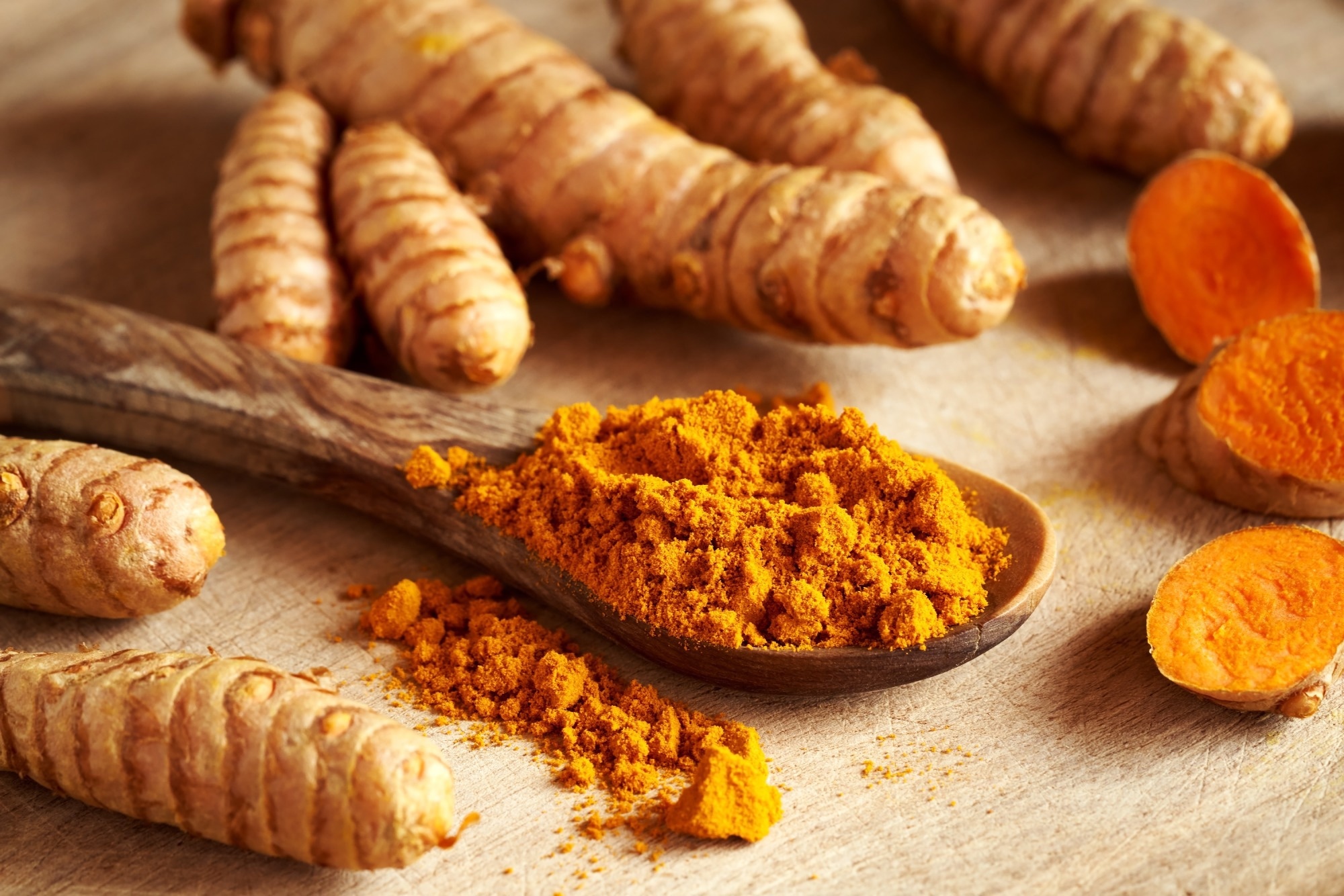In a recent study published in Viruses, researchers investigated the efficacy of curcumin as a blue light photosensitizing agent for photodynamic therapy (PDT), as a prophylactic agent, and as a therapeutic agent against severe acute respiratory syndrome coronavirus 2 (SARS-CoV-2).
 Study: Optimization of Anti-SARS-CoV-2 Treatments Based on Curcumin, Used Alone or Employed as a Photosensitizer. Image Credit: Madeleine Steinbach/Shutterstock
Study: Optimization of Anti-SARS-CoV-2 Treatments Based on Curcumin, Used Alone or Employed as a Photosensitizer. Image Credit: Madeleine Steinbach/Shutterstock
Background
The continual emergence of SARS-CoV-2 variants has threatened vaccine efficacy and warrants the development of non-vaccine strategies and therapeutic agents for coronavirus disease 2019 (COVID-19) mitigation. Curcumin is the bioactive compound obtained from the spice Curcuma longa and has demonstrated promising potential as an adjunct to COVID-19 therapeutics due to its anti-inflammatory and immunomodulatory properties. Recent studies have documented SARS-CoV-2 neutralization by curcumin in vitro after one to two hours of incubation and when curcumin was used before or after SARS-CoV-2 infection.
Nano-curcumin formulations have reduced SARS-CoV-2 spike (S) protein-induced inflammation in vitro and have effectively ameliorated COVID-19 symptomatology. PDT using curcumin nanoparticles to photosensitize blue light showed SARS-CoV-2 inhibitory effects concerning cell viability post-treatment compared to untreated SARS-CoV-2-exposed cells.
About the study
The present study explored the prophylactic, therapeutic, and photosensitizing anti-SARS-CoV-2 efficacy.
Vero E6 cells were challenged with the SARS-CoV-2 Delta variant and curcumin in varying concentrations (0.05, 0.1, 0.5, 1.0, 5.0, and 10.0 µM) for cell culture experiments (setting 1). The cells were monitored for a week. Subsequently, ribonuclease (RNase) protection assays were performed.
To investigate if curcumin can be effectively used for SARS-CoV-2 prophylaxis and treatment, Vero E6 cells were subjected to curcumin pre-treatment for an hour, following which the team removed curcumin (setting 2), and the Vero E6 cells were SARS-CoV-2-inoculated for an hour. Further, Vero E6 cells were SARS-CoV-2-inoculated for an hour, post-which the culture supernatants were discarded, and the Vero E6 cells were curcumin-treated for an hour (setting 3).
To reduce the curcumin dose effective against SARS-CoV-2, PDT therapy using curcumin as a 445nm blue light photosensitizing agent was performed. A mixture of SARS-CoV-2 and curcumin at concentrations with no previously demonstrated antiviral effects (0.05, 0.1, 0.5, 1.0, and 5.0 µM) were prepared, and subsequently, class IV-type diode lasers were used for irradiation.
After irradiation, Vero E6 cells were treated with the SARS-CoV-2-curcumin mixture, the culture supernatants were removed, and another medium was used (setting 4). After each experiment, SARS-CoV-2 ribonucleic acid (RNA) viral loads in the culture supernatants were determined by real-time polymerase chain reaction (PCR), targeting the SARS-CoV-2 nucleocapsid (N) gene. Cell viability evaluations were performed after a week of infection/treatment.
Results
Curcumin in 10.0 µM concentration inhibited SARS-CoV-2 replication (>99% reduction) in Vero E6 cells, and the viral loads in the SARS-CoV-2-infected and curcumin-treated cells were 107 SARS-CoV-2 RNA copies per mL on the fourth day and seventh day. In Vero E6 cells incubated with untreated SARS-CoV-2, viral loads increased to 108 and 1010 SARS-CoV-2 RNA copies per mL on the fourth day and seventh day, respectively.
The ribonuclease protection assays showed significantly reduced RNA levels, from 2.9 × 108 SARS-CoV-2 RNA copies per mL to 6.0 × 105 SARS-CoV-2 RNA copies per mL on the treatment of SARS-CoV-2 with 10 µM curcumin, indicating the anti-SARS-CoV-2 efficacy was probably due to partial SARS-CoV-2 virion structure disruption. However, curcumin was not effective against SARS-CoV-2 as a prophylactic agent.
Of interest, a nearly complete (>99%) diminution in viral loads was found in the Vero E6 cells that were challenged with PDT-treated SARS-CoV-2 (curcumin at 1 and 5 µM) in comparison to cells inoculated with untreated SARS-CoV-2, and to Vero E6 cells treated with SARS-CoV-2 challenged with curcumin only. The survival of cells inoculated with untreated SARS-CoV-2 reduced to 50% after one week.
Notably, when curcumin was employed as a photosensitizer, and blue laser light at 445 nm was delivered to a mixture of curcumin/SARS-CoV-2 before inoculation on the cells, virus inactivation was observed (>99%) using curcumin doses not antiviral by themselves. The results obtained for cells challenged with 10.0 µM curcumin treated-virus, and PDT-treated virus (treatment with 1.0 µM and 5.0 µM curcumin concentrations) were similar to those obtained for uninfected cells.
Based on the study findings, curcumin can be used for PDT against SARS-CoV-2.